Analysing Communication Barriers & Strategies in Bri-tech IT
VerifiedAdded on 2023/06/14
|8
|1980
|275
Report
AI Summary
This report examines business communication challenges within Bri-tech IT, focusing on employee reluctance to return to the office post-pandemic. It explores organizational communication theories, including Weber's bureaucratic model, Tompkins and Cheney's control theory, and Deetz's managerialism theory, highlighting how these theories relate to the company's communication structure. The report identifies physical, emotional, organizational, perceptual, and interpersonal barriers hindering employees' return. To address these, it proposes strategies such as providing conveyance, ensuring social distancing, establishing clear work guidelines, promoting employee vaccination, and fostering orientation and interaction activities. The analysis concludes that overcoming these barriers requires a multifaceted approach to rebuild effective communication and collaboration within Bri-tech IT.
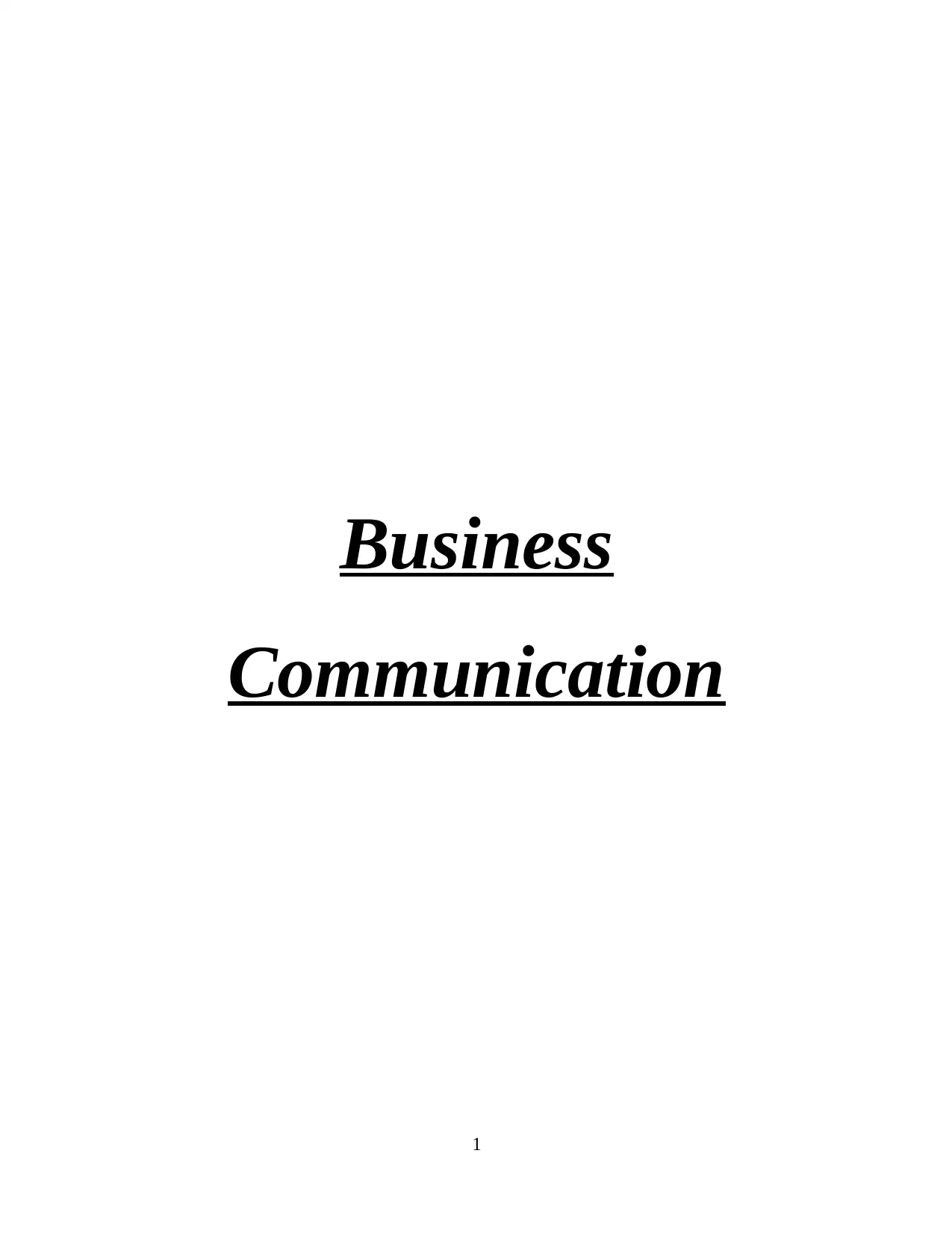
Business
Communication
1
Communication
1
Paraphrase This Document
Need a fresh take? Get an instant paraphrase of this document with our AI Paraphraser
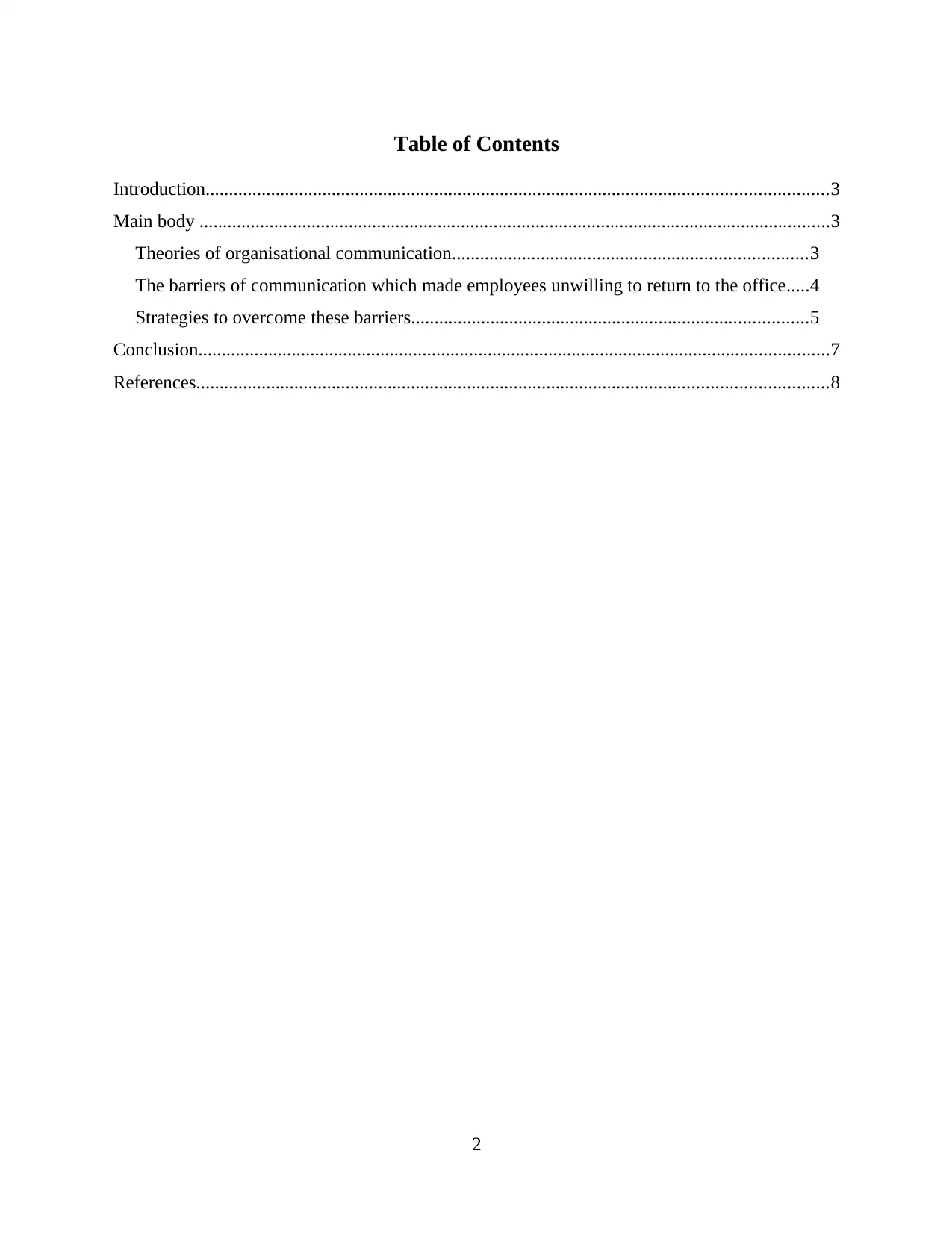
Table of Contents
Introduction.....................................................................................................................................3
Main body .......................................................................................................................................3
Theories of organisational communication............................................................................3
The barriers of communication which made employees unwilling to return to the office.....4
Strategies to overcome these barriers.....................................................................................5
Conclusion.......................................................................................................................................7
References.......................................................................................................................................8
2
Introduction.....................................................................................................................................3
Main body .......................................................................................................................................3
Theories of organisational communication............................................................................3
The barriers of communication which made employees unwilling to return to the office.....4
Strategies to overcome these barriers.....................................................................................5
Conclusion.......................................................................................................................................7
References.......................................................................................................................................8
2
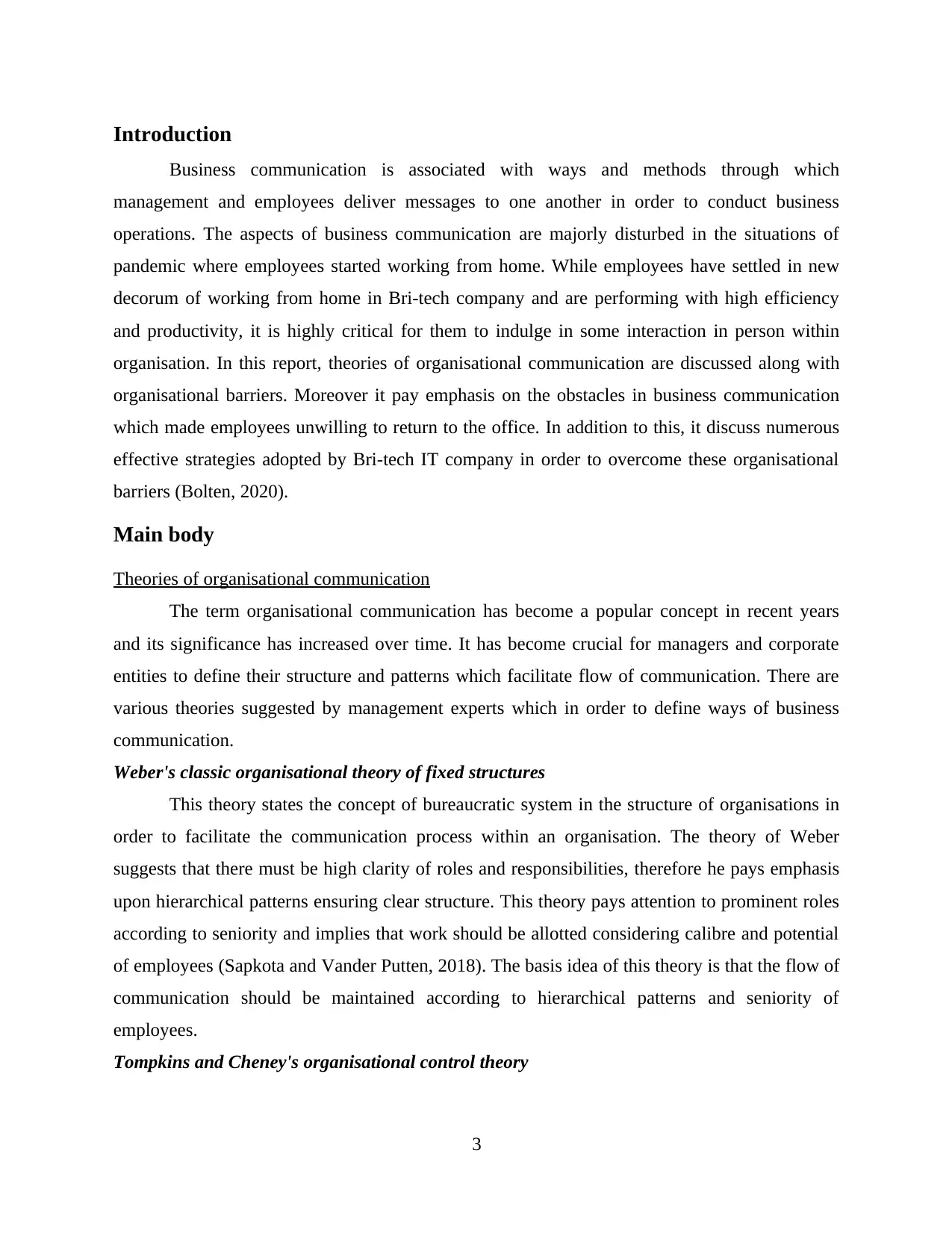
Introduction
Business communication is associated with ways and methods through which
management and employees deliver messages to one another in order to conduct business
operations. The aspects of business communication are majorly disturbed in the situations of
pandemic where employees started working from home. While employees have settled in new
decorum of working from home in Bri-tech company and are performing with high efficiency
and productivity, it is highly critical for them to indulge in some interaction in person within
organisation. In this report, theories of organisational communication are discussed along with
organisational barriers. Moreover it pay emphasis on the obstacles in business communication
which made employees unwilling to return to the office. In addition to this, it discuss numerous
effective strategies adopted by Bri-tech IT company in order to overcome these organisational
barriers (Bolten, 2020).
Main body
Theories of organisational communication
The term organisational communication has become a popular concept in recent years
and its significance has increased over time. It has become crucial for managers and corporate
entities to define their structure and patterns which facilitate flow of communication. There are
various theories suggested by management experts which in order to define ways of business
communication.
Weber's classic organisational theory of fixed structures
This theory states the concept of bureaucratic system in the structure of organisations in
order to facilitate the communication process within an organisation. The theory of Weber
suggests that there must be high clarity of roles and responsibilities, therefore he pays emphasis
upon hierarchical patterns ensuring clear structure. This theory pays attention to prominent roles
according to seniority and implies that work should be allotted considering calibre and potential
of employees (Sapkota and Vander Putten, 2018). The basis idea of this theory is that the flow of
communication should be maintained according to hierarchical patterns and seniority of
employees.
Tompkins and Cheney's organisational control theory
3
Business communication is associated with ways and methods through which
management and employees deliver messages to one another in order to conduct business
operations. The aspects of business communication are majorly disturbed in the situations of
pandemic where employees started working from home. While employees have settled in new
decorum of working from home in Bri-tech company and are performing with high efficiency
and productivity, it is highly critical for them to indulge in some interaction in person within
organisation. In this report, theories of organisational communication are discussed along with
organisational barriers. Moreover it pay emphasis on the obstacles in business communication
which made employees unwilling to return to the office. In addition to this, it discuss numerous
effective strategies adopted by Bri-tech IT company in order to overcome these organisational
barriers (Bolten, 2020).
Main body
Theories of organisational communication
The term organisational communication has become a popular concept in recent years
and its significance has increased over time. It has become crucial for managers and corporate
entities to define their structure and patterns which facilitate flow of communication. There are
various theories suggested by management experts which in order to define ways of business
communication.
Weber's classic organisational theory of fixed structures
This theory states the concept of bureaucratic system in the structure of organisations in
order to facilitate the communication process within an organisation. The theory of Weber
suggests that there must be high clarity of roles and responsibilities, therefore he pays emphasis
upon hierarchical patterns ensuring clear structure. This theory pays attention to prominent roles
according to seniority and implies that work should be allotted considering calibre and potential
of employees (Sapkota and Vander Putten, 2018). The basis idea of this theory is that the flow of
communication should be maintained according to hierarchical patterns and seniority of
employees.
Tompkins and Cheney's organisational control theory
3
⊘ This is a preview!⊘
Do you want full access?
Subscribe today to unlock all pages.

Trusted by 1+ million students worldwide
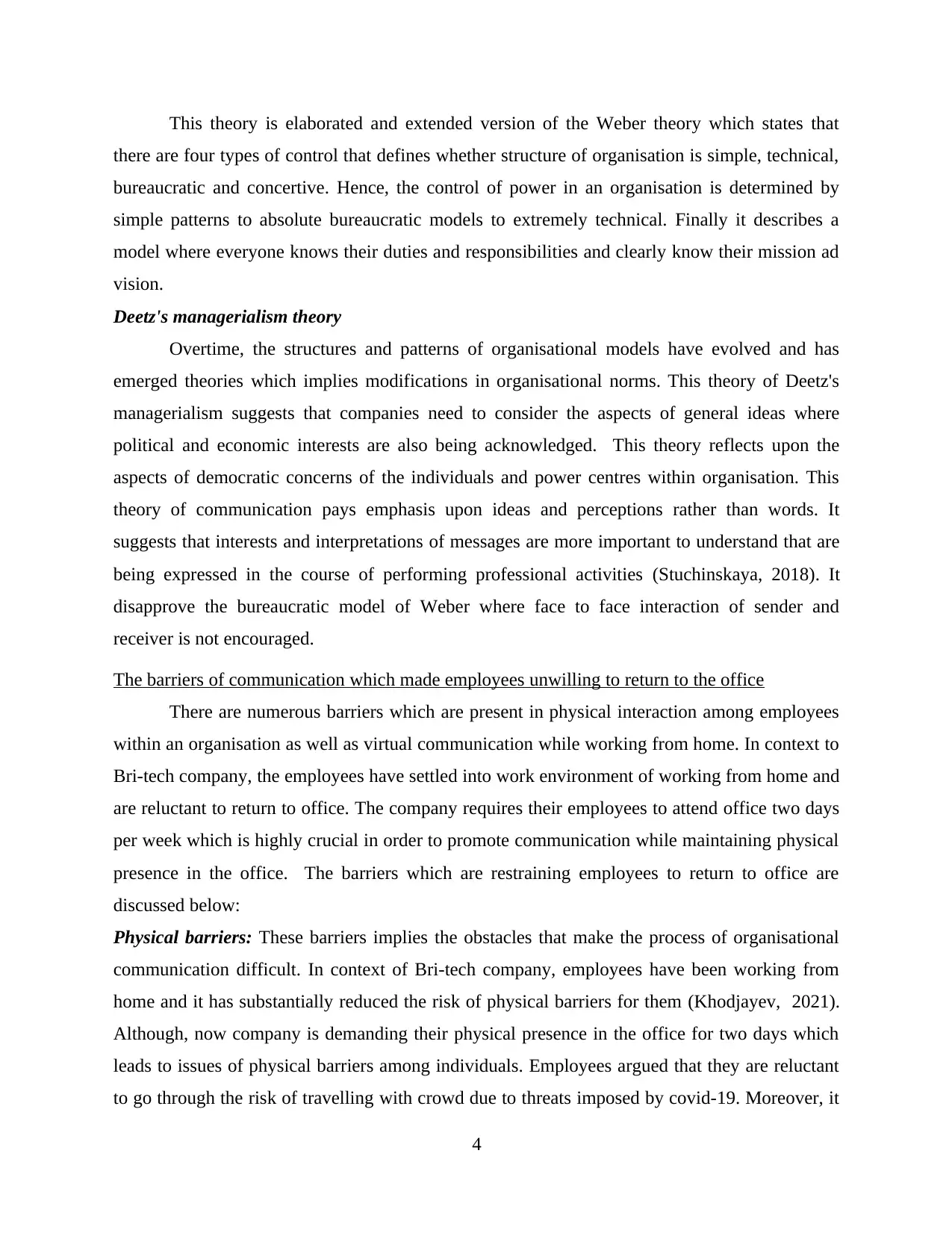
This theory is elaborated and extended version of the Weber theory which states that
there are four types of control that defines whether structure of organisation is simple, technical,
bureaucratic and concertive. Hence, the control of power in an organisation is determined by
simple patterns to absolute bureaucratic models to extremely technical. Finally it describes a
model where everyone knows their duties and responsibilities and clearly know their mission ad
vision.
Deetz's managerialism theory
Overtime, the structures and patterns of organisational models have evolved and has
emerged theories which implies modifications in organisational norms. This theory of Deetz's
managerialism suggests that companies need to consider the aspects of general ideas where
political and economic interests are also being acknowledged. This theory reflects upon the
aspects of democratic concerns of the individuals and power centres within organisation. This
theory of communication pays emphasis upon ideas and perceptions rather than words. It
suggests that interests and interpretations of messages are more important to understand that are
being expressed in the course of performing professional activities (Stuchinskaya, 2018). It
disapprove the bureaucratic model of Weber where face to face interaction of sender and
receiver is not encouraged.
The barriers of communication which made employees unwilling to return to the office
There are numerous barriers which are present in physical interaction among employees
within an organisation as well as virtual communication while working from home. In context to
Bri-tech company, the employees have settled into work environment of working from home and
are reluctant to return to office. The company requires their employees to attend office two days
per week which is highly crucial in order to promote communication while maintaining physical
presence in the office. The barriers which are restraining employees to return to office are
discussed below:
Physical barriers: These barriers implies the obstacles that make the process of organisational
communication difficult. In context of Bri-tech company, employees have been working from
home and it has substantially reduced the risk of physical barriers for them (Khodjayev, 2021).
Although, now company is demanding their physical presence in the office for two days which
leads to issues of physical barriers among individuals. Employees argued that they are reluctant
to go through the risk of travelling with crowd due to threats imposed by covid-19. Moreover, it
4
there are four types of control that defines whether structure of organisation is simple, technical,
bureaucratic and concertive. Hence, the control of power in an organisation is determined by
simple patterns to absolute bureaucratic models to extremely technical. Finally it describes a
model where everyone knows their duties and responsibilities and clearly know their mission ad
vision.
Deetz's managerialism theory
Overtime, the structures and patterns of organisational models have evolved and has
emerged theories which implies modifications in organisational norms. This theory of Deetz's
managerialism suggests that companies need to consider the aspects of general ideas where
political and economic interests are also being acknowledged. This theory reflects upon the
aspects of democratic concerns of the individuals and power centres within organisation. This
theory of communication pays emphasis upon ideas and perceptions rather than words. It
suggests that interests and interpretations of messages are more important to understand that are
being expressed in the course of performing professional activities (Stuchinskaya, 2018). It
disapprove the bureaucratic model of Weber where face to face interaction of sender and
receiver is not encouraged.
The barriers of communication which made employees unwilling to return to the office
There are numerous barriers which are present in physical interaction among employees
within an organisation as well as virtual communication while working from home. In context to
Bri-tech company, the employees have settled into work environment of working from home and
are reluctant to return to office. The company requires their employees to attend office two days
per week which is highly crucial in order to promote communication while maintaining physical
presence in the office. The barriers which are restraining employees to return to office are
discussed below:
Physical barriers: These barriers implies the obstacles that make the process of organisational
communication difficult. In context of Bri-tech company, employees have been working from
home and it has substantially reduced the risk of physical barriers for them (Khodjayev, 2021).
Although, now company is demanding their physical presence in the office for two days which
leads to issues of physical barriers among individuals. Employees argued that they are reluctant
to go through the risk of travelling with crowd due to threats imposed by covid-19. Moreover, it
4
Paraphrase This Document
Need a fresh take? Get an instant paraphrase of this document with our AI Paraphraser
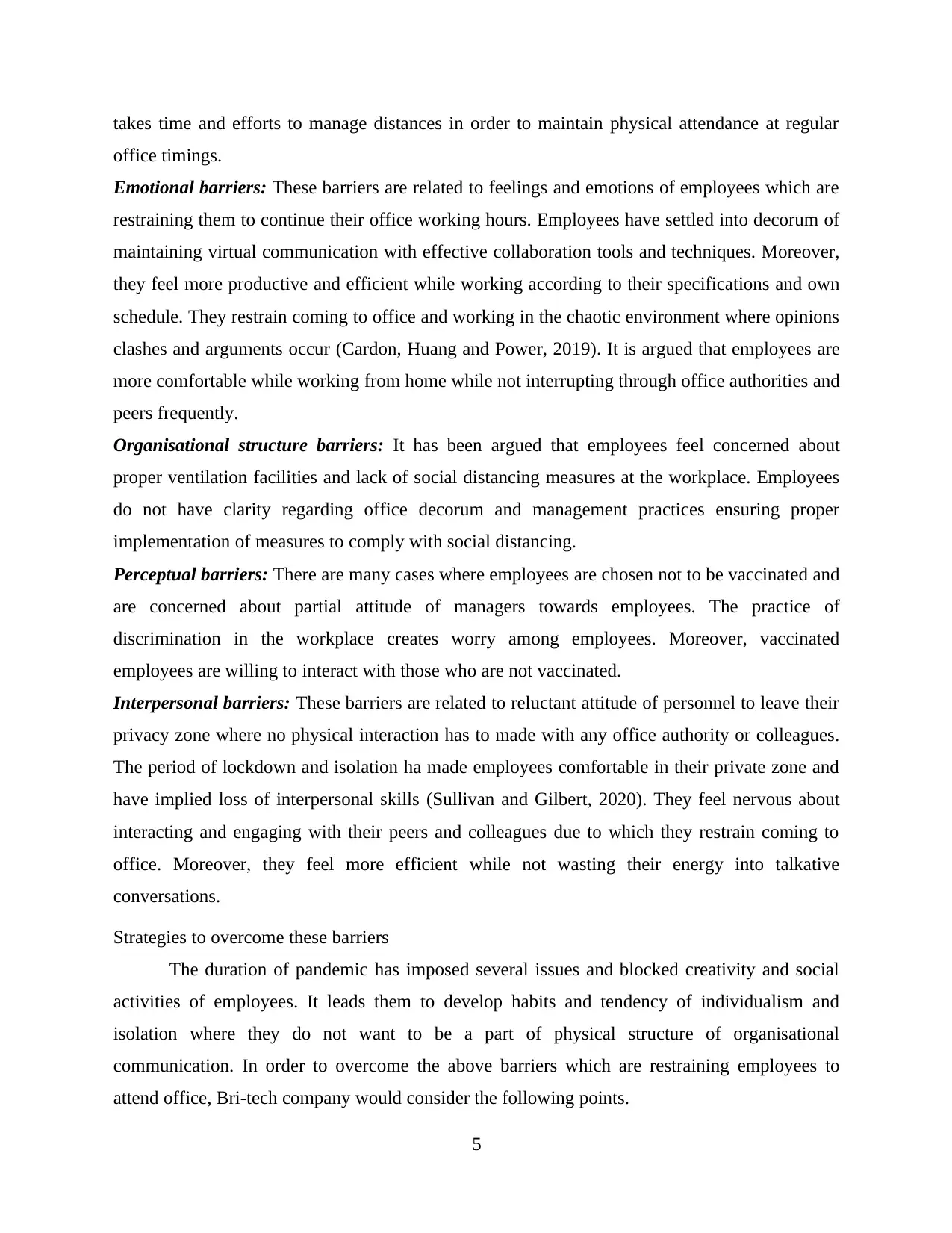
takes time and efforts to manage distances in order to maintain physical attendance at regular
office timings.
Emotional barriers: These barriers are related to feelings and emotions of employees which are
restraining them to continue their office working hours. Employees have settled into decorum of
maintaining virtual communication with effective collaboration tools and techniques. Moreover,
they feel more productive and efficient while working according to their specifications and own
schedule. They restrain coming to office and working in the chaotic environment where opinions
clashes and arguments occur (Cardon, Huang and Power, 2019). It is argued that employees are
more comfortable while working from home while not interrupting through office authorities and
peers frequently.
Organisational structure barriers: It has been argued that employees feel concerned about
proper ventilation facilities and lack of social distancing measures at the workplace. Employees
do not have clarity regarding office decorum and management practices ensuring proper
implementation of measures to comply with social distancing.
Perceptual barriers: There are many cases where employees are chosen not to be vaccinated and
are concerned about partial attitude of managers towards employees. The practice of
discrimination in the workplace creates worry among employees. Moreover, vaccinated
employees are willing to interact with those who are not vaccinated.
Interpersonal barriers: These barriers are related to reluctant attitude of personnel to leave their
privacy zone where no physical interaction has to made with any office authority or colleagues.
The period of lockdown and isolation ha made employees comfortable in their private zone and
have implied loss of interpersonal skills (Sullivan and Gilbert, 2020). They feel nervous about
interacting and engaging with their peers and colleagues due to which they restrain coming to
office. Moreover, they feel more efficient while not wasting their energy into talkative
conversations.
Strategies to overcome these barriers
The duration of pandemic has imposed several issues and blocked creativity and social
activities of employees. It leads them to develop habits and tendency of individualism and
isolation where they do not want to be a part of physical structure of organisational
communication. In order to overcome the above barriers which are restraining employees to
attend office, Bri-tech company would consider the following points.
5
office timings.
Emotional barriers: These barriers are related to feelings and emotions of employees which are
restraining them to continue their office working hours. Employees have settled into decorum of
maintaining virtual communication with effective collaboration tools and techniques. Moreover,
they feel more productive and efficient while working according to their specifications and own
schedule. They restrain coming to office and working in the chaotic environment where opinions
clashes and arguments occur (Cardon, Huang and Power, 2019). It is argued that employees are
more comfortable while working from home while not interrupting through office authorities and
peers frequently.
Organisational structure barriers: It has been argued that employees feel concerned about
proper ventilation facilities and lack of social distancing measures at the workplace. Employees
do not have clarity regarding office decorum and management practices ensuring proper
implementation of measures to comply with social distancing.
Perceptual barriers: There are many cases where employees are chosen not to be vaccinated and
are concerned about partial attitude of managers towards employees. The practice of
discrimination in the workplace creates worry among employees. Moreover, vaccinated
employees are willing to interact with those who are not vaccinated.
Interpersonal barriers: These barriers are related to reluctant attitude of personnel to leave their
privacy zone where no physical interaction has to made with any office authority or colleagues.
The period of lockdown and isolation ha made employees comfortable in their private zone and
have implied loss of interpersonal skills (Sullivan and Gilbert, 2020). They feel nervous about
interacting and engaging with their peers and colleagues due to which they restrain coming to
office. Moreover, they feel more efficient while not wasting their energy into talkative
conversations.
Strategies to overcome these barriers
The duration of pandemic has imposed several issues and blocked creativity and social
activities of employees. It leads them to develop habits and tendency of individualism and
isolation where they do not want to be a part of physical structure of organisational
communication. In order to overcome the above barriers which are restraining employees to
attend office, Bri-tech company would consider the following points.
5
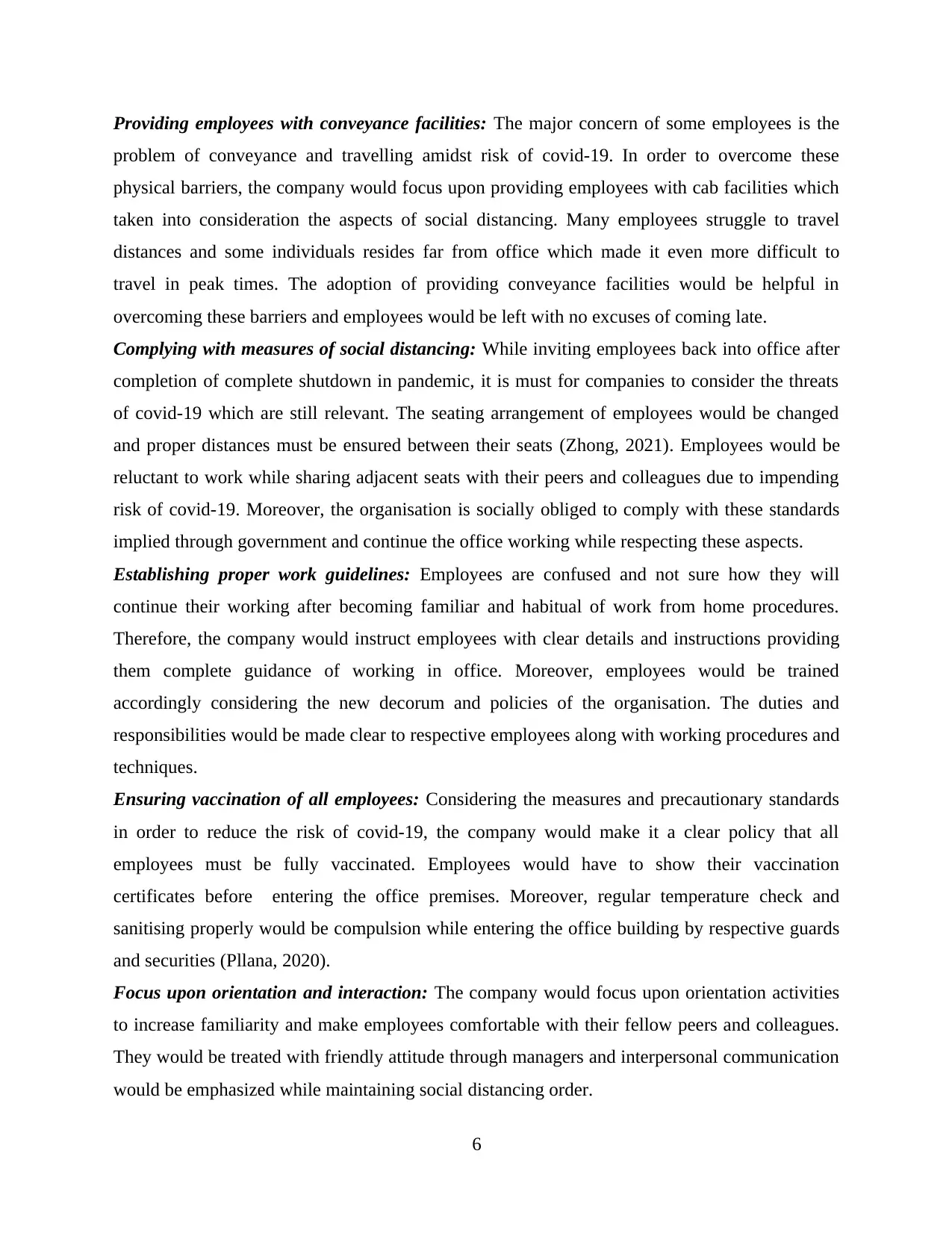
Providing employees with conveyance facilities: The major concern of some employees is the
problem of conveyance and travelling amidst risk of covid-19. In order to overcome these
physical barriers, the company would focus upon providing employees with cab facilities which
taken into consideration the aspects of social distancing. Many employees struggle to travel
distances and some individuals resides far from office which made it even more difficult to
travel in peak times. The adoption of providing conveyance facilities would be helpful in
overcoming these barriers and employees would be left with no excuses of coming late.
Complying with measures of social distancing: While inviting employees back into office after
completion of complete shutdown in pandemic, it is must for companies to consider the threats
of covid-19 which are still relevant. The seating arrangement of employees would be changed
and proper distances must be ensured between their seats (Zhong, 2021). Employees would be
reluctant to work while sharing adjacent seats with their peers and colleagues due to impending
risk of covid-19. Moreover, the organisation is socially obliged to comply with these standards
implied through government and continue the office working while respecting these aspects.
Establishing proper work guidelines: Employees are confused and not sure how they will
continue their working after becoming familiar and habitual of work from home procedures.
Therefore, the company would instruct employees with clear details and instructions providing
them complete guidance of working in office. Moreover, employees would be trained
accordingly considering the new decorum and policies of the organisation. The duties and
responsibilities would be made clear to respective employees along with working procedures and
techniques.
Ensuring vaccination of all employees: Considering the measures and precautionary standards
in order to reduce the risk of covid-19, the company would make it a clear policy that all
employees must be fully vaccinated. Employees would have to show their vaccination
certificates before entering the office premises. Moreover, regular temperature check and
sanitising properly would be compulsion while entering the office building by respective guards
and securities (Pllana, 2020).
Focus upon orientation and interaction: The company would focus upon orientation activities
to increase familiarity and make employees comfortable with their fellow peers and colleagues.
They would be treated with friendly attitude through managers and interpersonal communication
would be emphasized while maintaining social distancing order.
6
problem of conveyance and travelling amidst risk of covid-19. In order to overcome these
physical barriers, the company would focus upon providing employees with cab facilities which
taken into consideration the aspects of social distancing. Many employees struggle to travel
distances and some individuals resides far from office which made it even more difficult to
travel in peak times. The adoption of providing conveyance facilities would be helpful in
overcoming these barriers and employees would be left with no excuses of coming late.
Complying with measures of social distancing: While inviting employees back into office after
completion of complete shutdown in pandemic, it is must for companies to consider the threats
of covid-19 which are still relevant. The seating arrangement of employees would be changed
and proper distances must be ensured between their seats (Zhong, 2021). Employees would be
reluctant to work while sharing adjacent seats with their peers and colleagues due to impending
risk of covid-19. Moreover, the organisation is socially obliged to comply with these standards
implied through government and continue the office working while respecting these aspects.
Establishing proper work guidelines: Employees are confused and not sure how they will
continue their working after becoming familiar and habitual of work from home procedures.
Therefore, the company would instruct employees with clear details and instructions providing
them complete guidance of working in office. Moreover, employees would be trained
accordingly considering the new decorum and policies of the organisation. The duties and
responsibilities would be made clear to respective employees along with working procedures and
techniques.
Ensuring vaccination of all employees: Considering the measures and precautionary standards
in order to reduce the risk of covid-19, the company would make it a clear policy that all
employees must be fully vaccinated. Employees would have to show their vaccination
certificates before entering the office premises. Moreover, regular temperature check and
sanitising properly would be compulsion while entering the office building by respective guards
and securities (Pllana, 2020).
Focus upon orientation and interaction: The company would focus upon orientation activities
to increase familiarity and make employees comfortable with their fellow peers and colleagues.
They would be treated with friendly attitude through managers and interpersonal communication
would be emphasized while maintaining social distancing order.
6
⊘ This is a preview!⊘
Do you want full access?
Subscribe today to unlock all pages.

Trusted by 1+ million students worldwide
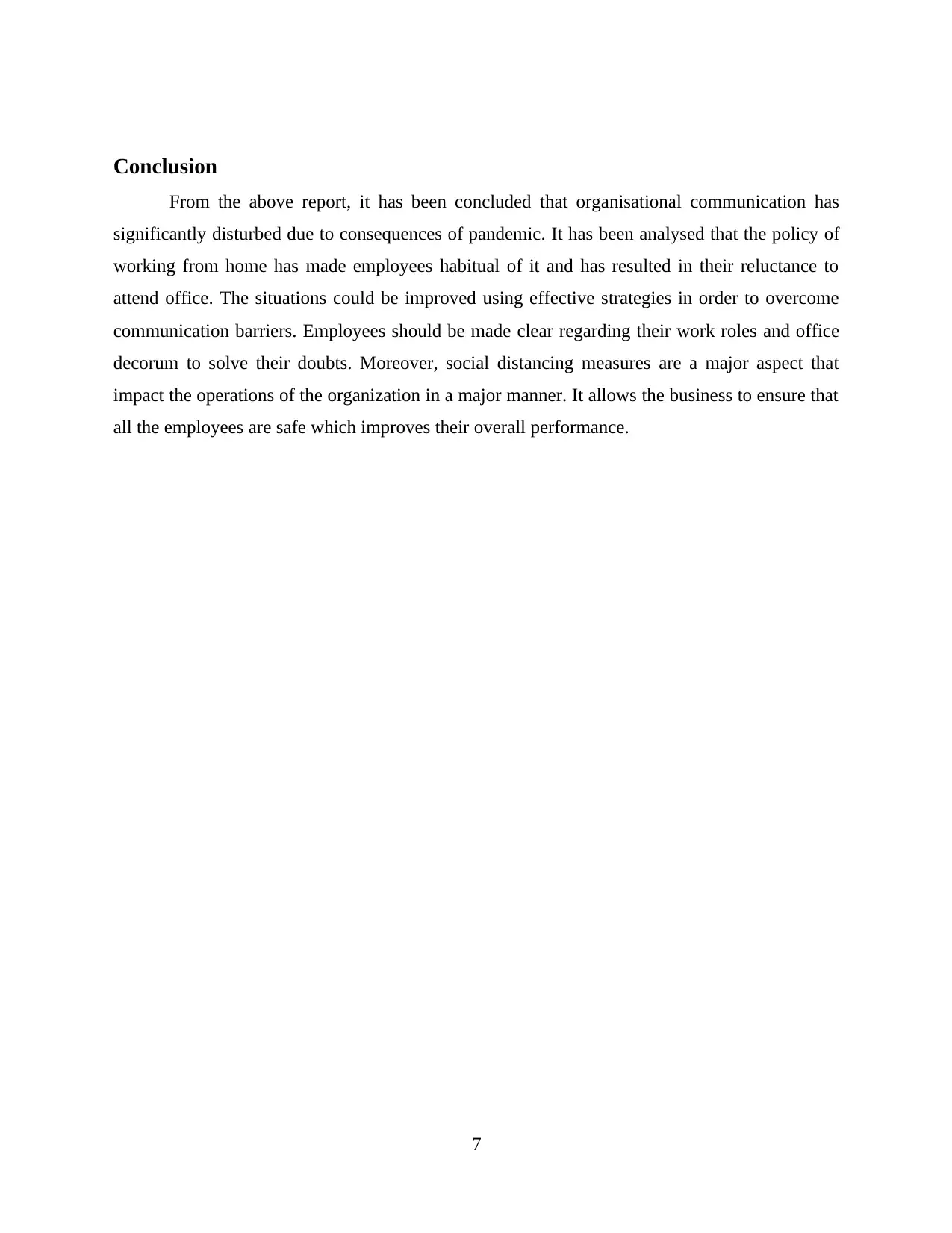
Conclusion
From the above report, it has been concluded that organisational communication has
significantly disturbed due to consequences of pandemic. It has been analysed that the policy of
working from home has made employees habitual of it and has resulted in their reluctance to
attend office. The situations could be improved using effective strategies in order to overcome
communication barriers. Employees should be made clear regarding their work roles and office
decorum to solve their doubts. Moreover, social distancing measures are a major aspect that
impact the operations of the organization in a major manner. It allows the business to ensure that
all the employees are safe which improves their overall performance.
7
From the above report, it has been concluded that organisational communication has
significantly disturbed due to consequences of pandemic. It has been analysed that the policy of
working from home has made employees habitual of it and has resulted in their reluctance to
attend office. The situations could be improved using effective strategies in order to overcome
communication barriers. Employees should be made clear regarding their work roles and office
decorum to solve their doubts. Moreover, social distancing measures are a major aspect that
impact the operations of the organization in a major manner. It allows the business to ensure that
all the employees are safe which improves their overall performance.
7
Paraphrase This Document
Need a fresh take? Get an instant paraphrase of this document with our AI Paraphraser
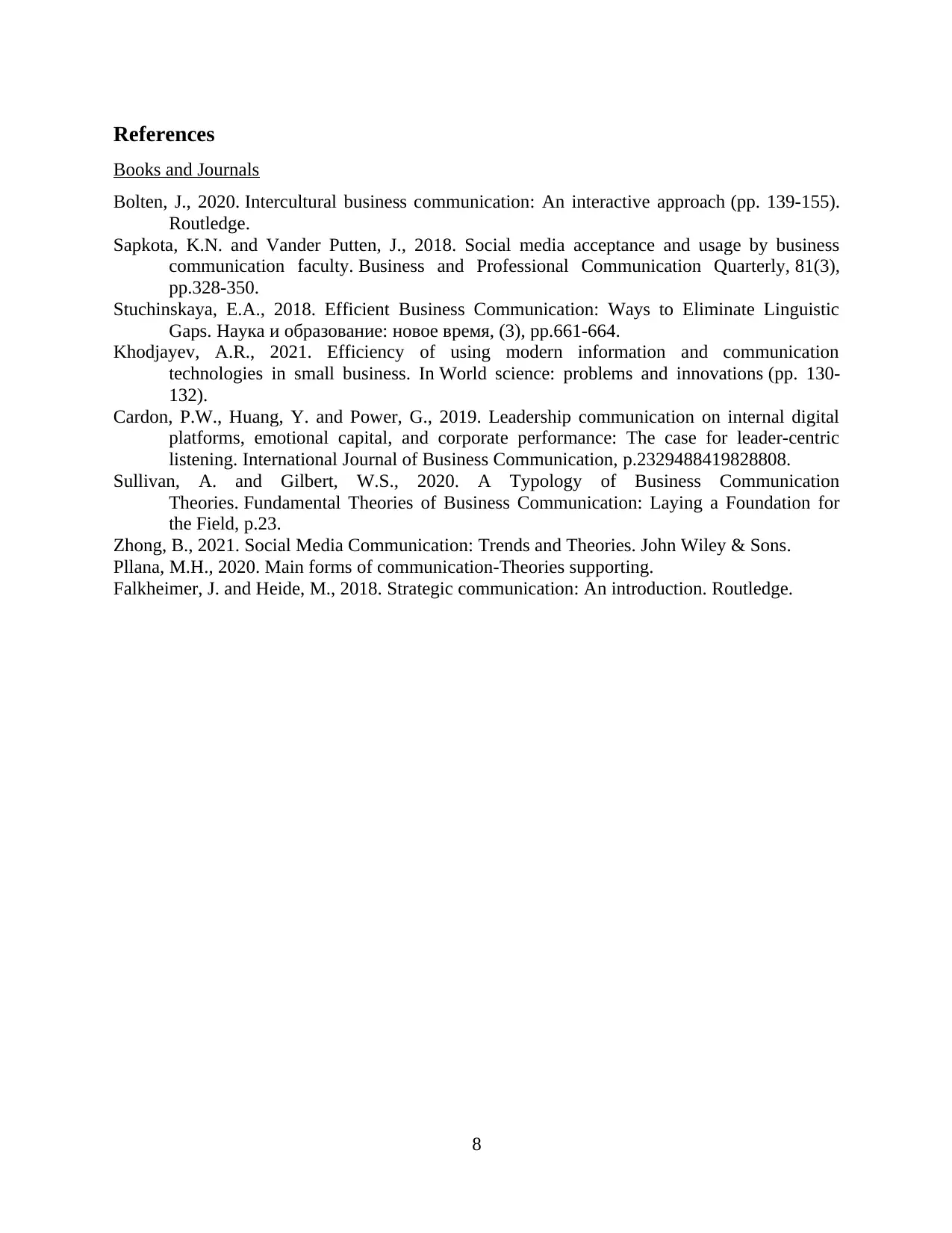
References
Books and Journals
Bolten, J., 2020. Intercultural business communication: An interactive approach (pp. 139-155).
Routledge.
Sapkota, K.N. and Vander Putten, J., 2018. Social media acceptance and usage by business
communication faculty. Business and Professional Communication Quarterly, 81(3),
pp.328-350.
Stuchinskaya, E.A., 2018. Efficient Business Communication: Ways to Eliminate Linguistic
Gaps. Наука и образование: новое время, (3), pp.661-664.
Khodjayev, A.R., 2021. Efficiency of using modern information and communication
technologies in small business. In World science: problems and innovations (pp. 130-
132).
Cardon, P.W., Huang, Y. and Power, G., 2019. Leadership communication on internal digital
platforms, emotional capital, and corporate performance: The case for leader-centric
listening. International Journal of Business Communication, p.2329488419828808.
Sullivan, A. and Gilbert, W.S., 2020. A Typology of Business Communication
Theories. Fundamental Theories of Business Communication: Laying a Foundation for
the Field, p.23.
Zhong, B., 2021. Social Media Communication: Trends and Theories. John Wiley & Sons.
Pllana, M.H., 2020. Main forms of communication-Theories supporting.
Falkheimer, J. and Heide, M., 2018. Strategic communication: An introduction. Routledge.
8
Books and Journals
Bolten, J., 2020. Intercultural business communication: An interactive approach (pp. 139-155).
Routledge.
Sapkota, K.N. and Vander Putten, J., 2018. Social media acceptance and usage by business
communication faculty. Business and Professional Communication Quarterly, 81(3),
pp.328-350.
Stuchinskaya, E.A., 2018. Efficient Business Communication: Ways to Eliminate Linguistic
Gaps. Наука и образование: новое время, (3), pp.661-664.
Khodjayev, A.R., 2021. Efficiency of using modern information and communication
technologies in small business. In World science: problems and innovations (pp. 130-
132).
Cardon, P.W., Huang, Y. and Power, G., 2019. Leadership communication on internal digital
platforms, emotional capital, and corporate performance: The case for leader-centric
listening. International Journal of Business Communication, p.2329488419828808.
Sullivan, A. and Gilbert, W.S., 2020. A Typology of Business Communication
Theories. Fundamental Theories of Business Communication: Laying a Foundation for
the Field, p.23.
Zhong, B., 2021. Social Media Communication: Trends and Theories. John Wiley & Sons.
Pllana, M.H., 2020. Main forms of communication-Theories supporting.
Falkheimer, J. and Heide, M., 2018. Strategic communication: An introduction. Routledge.
8
1 out of 8
Related Documents
Your All-in-One AI-Powered Toolkit for Academic Success.
+13062052269
info@desklib.com
Available 24*7 on WhatsApp / Email
![[object Object]](/_next/static/media/star-bottom.7253800d.svg)
Unlock your academic potential
Copyright © 2020–2025 A2Z Services. All Rights Reserved. Developed and managed by ZUCOL.





